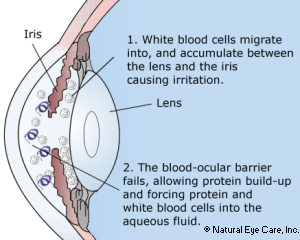Iritis (eye pain)
Vitamins/Supplements Symptoms Causes News
Iritis (more correctly classified as anterior uveitis) is an inflammation of the iris. It may include inflammation of the ciliary body (cyclitis), which is located behind the iris. In iritis, small white blood cells from the inflamed area and excess protein that leaked from the small blood vessels inside the eye float into the aqueous fluid between the iris and the cornea. The iris becomes inflamed and is often experienced as a painful red eye.
Posterior uveitis (choroiditis) is a related condition in which the inflammation extends to the retina and choroid.
There are two types of iritis: acute (nongranulomatous) and chronic (granulomatous).
Acute, traumatic iritis occurs suddenly and is sometimes caused by trauma or injury to the eye. It can be quite painful, but it generally heals on its own within several weeks. This is the most common form of iritis.
Chronic, non-traumatic, and recurring iritis can last for months or years. It responds less readily to treatment than acute iritis and increases the risk of damage to vision. Complications of chronic iritis can include glaucoma, cataracts, cystoid macular edema, corneal calcification, posterior calcification, and possibly blindness. It can be related to a systemic disease or other ocular condition.
Nongranulomatous (acute) Iritis

While acute iritis is often caused by trauma to the eye, it is sometimes difficult to determine the cause. Its most common form is linked to the human white blood cell antigen HLA-B27 gene mutation that is associated with psoriasis, ankylosing spondylitis, inflammatory bowel disease, and reactive arthritis. Environmental factors play an important role in HLA-B27’s capacity to trigger iritis, and bacterial triggers are most strongly implicated.
Examples of the wide range of hard-to-identify causes include treatment with intense pulsed light, a cosmetic iris implant, and dislocation of a posterior intraocular lens.
Granulomatous (chronic) Iritis
Chronic iritis may result from an autoimmune reaction or an immune response to systemic disease such as tuberculosis, Lyme disease, Bechet’s disease, sarcoidosis, lupus, juvenile rheumatoid arthritis, or herpes.
In general, granulomatous conditions are autoimmune-related conditions that make the body more vulnerable to bacterial and fungal infections. Granulomas are immune cells that collect at the location of infection. So, in the case of granulomatous iritis, this massing of immune cells takes place at the iris, causing redness and pain.
What Happens?

When the iris is inflamed, white blood cells (leukocytes) migrate into the anterior chamber of the eye. They can accumulate and adhere between the iris and the lens, causing irritation and inflammation.
Inflammation of the iris region apparently causes the blood-ocular barrier to deteriorate or fail, allowing protein build-up. This condition forces both protein and white blood cells into the aqueous fluid, resulting in the typical iritis symptoms.
Symptoms
- Redness
- Eye pain
- Throbbing pain
- Light Sensitivity
- Tearing
- The pupil may become smaller in the affected eye
- Blurred or cloudy vision
- Red eye
Causes
The causes of iritis may vary; they can be connected to problems or diseases occurring in the eye, or they may be a result of an inflammatory disease in other parts of the body, such as Crohn’s and ulcerative colitis. Physical trauma, autoimmune disorders, chronic systemic inflammation, and infections are all possible sources. However, it is important to know that iritis is most often a symptom of one or more other disease conditions in the body, and it may be the only symptom that is noticeable. Here is a summary of primary causes:
Blunt trauma to the eye (traumatic or nongranulomatous iritis), such as eye and head injury, problems arising from ocular surgery, or eye treatments and therapies
Association with other diseases or disorders (non-traumatic or granulomatous iritis), such as ankylosing spondylitis, sarcoidosis, Reiter syndrome, inflammatory bowel disease, psoriasis, and collagen vascular diseases such as lupus and cancers
Infectious illnesses (non-traumatic or granulomatous iritis), such as Lyme disease, syphilis, herpes simplex and herpes zoster viruses, tuberculosis, and toxoplasmosis
Iritis News
Want to learn more? See our blog news on iritis.
 info@naturaleyecare.com
info@naturaleyecare.com



 Home
Home



 Vision
Vision Vision
Vision



 Health
Health Health
Health Research/Services
Research/Services Pets
Pets About/Contact
About/Contact


